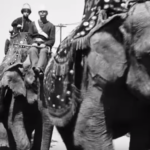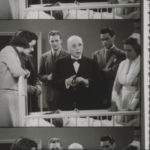How to Break into Movies — in 1907
With a long-ago birthday present from his grandmother, Darren Nemeth, a Michigan early-film enthusiast, has been able to publish a refurbished edition of a 1907 catalog that told traveling film exhibitors everything they needed to know if they were to succeed in the burgeoning business.
n
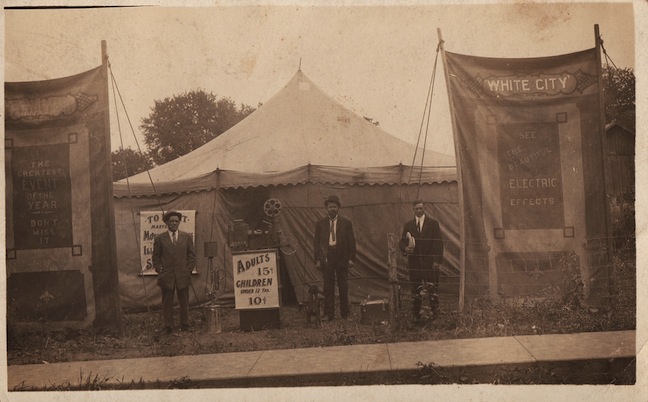
n
Thanks to a childhood fascination with movies, Darren Nemeth has published a rare document from the early days of cinema. It provides insight into an era of movie-going and movie presentation very different from our own.
One day, back when, he and his grandmother were at an antique store in Frankenmuth, a “little Bavaria” tourist town in Michigan state. Nemeth looked into a bag in a box on a shelf fashioned inside a closet… The two publications within caught his eye.
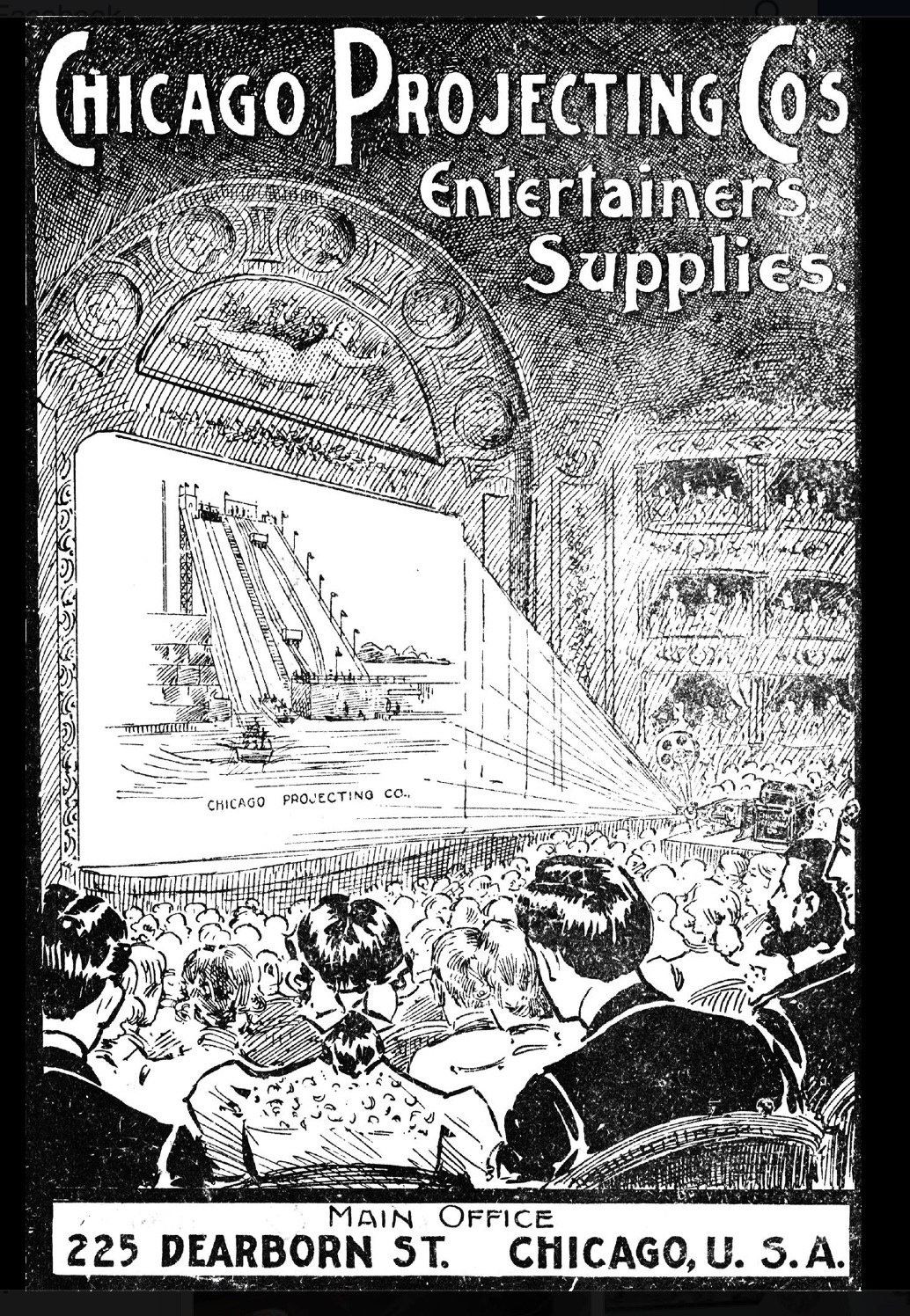
The catalog as it originally appeared
One was Motion Picture Handbook, by F. H. Richardson, from 1912, a guide for theater managers that “was so technical that I never really looked at it,” Nemeth recalls.
But the other was something that conjured in his mind visions of the infancy of film. It was Chicago Projecting Co.’s Entertainer’s Supplies Catalog No. 122, issued in 1907. The showman’s catalog had, he says, “absolutely everything that you would need to know and buy to run a traveling film show.”
The company’s pitch to enterprising young men [sic] of the time was that for a $200 outlay, they could purchase everything they would need to secure a handsome return. They could buy the necessary machinery, set up and decorate spaces for showing films whether in tents, shopfronts, churches, or other venues; they could buy the films.
Indeed, went the pitch, “no other business on earth paying as large a return can be started for so little money.”
Chicago Projecting sold all kinds of movie equipment and parts. Gas valves, calcium light jets, electric arc lamps… plenty to fascinate gear heads of today, just as it did the film-projection tinkerers of the early 1900s. Chicago Projecting also sold hundreds of films to feed the turn-of-the-century hunger for the new medium, as well as slide sets that continued a decades-old form of entertainment.
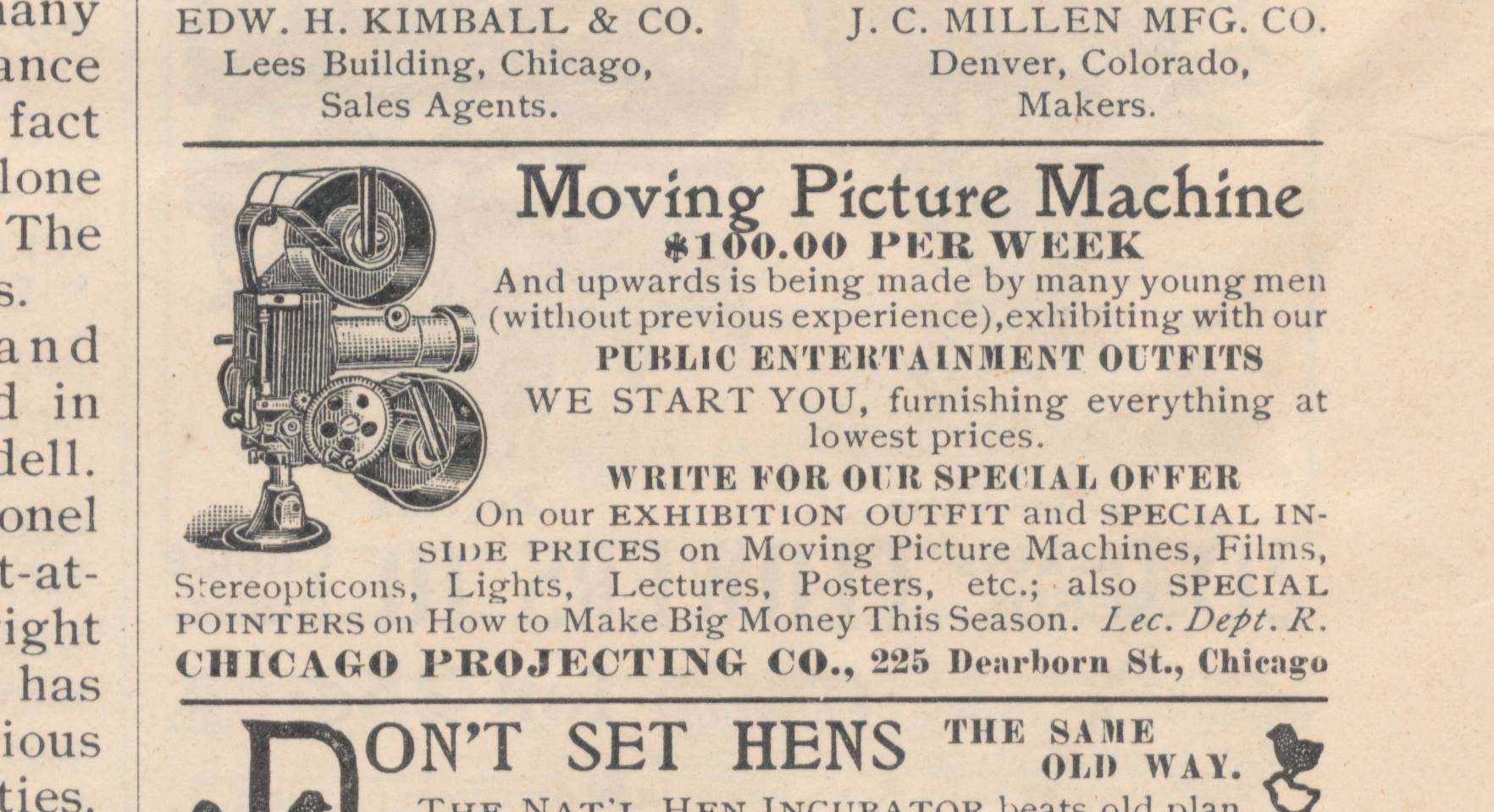 Nemeth explained the publication in a Spring 2016 article in The Silent Film Quarterly, titled “Preserving A Piece of Pre-Hollywood Cinema.” At the dawn of film, he noted, film distribution differed markedly from what it would become. Until about 1913, exhibiting was a traveling trade, Nemeth wrote: “Independent traveling showmen went from town to town on a train or by wagon and discarded things that had no use to them.”
Nemeth explained the publication in a Spring 2016 article in The Silent Film Quarterly, titled “Preserving A Piece of Pre-Hollywood Cinema.” At the dawn of film, he noted, film distribution differed markedly from what it would become. Until about 1913, exhibiting was a traveling trade, Nemeth wrote: “Independent traveling showmen went from town to town on a train or by wagon and discarded things that had no use to them.”
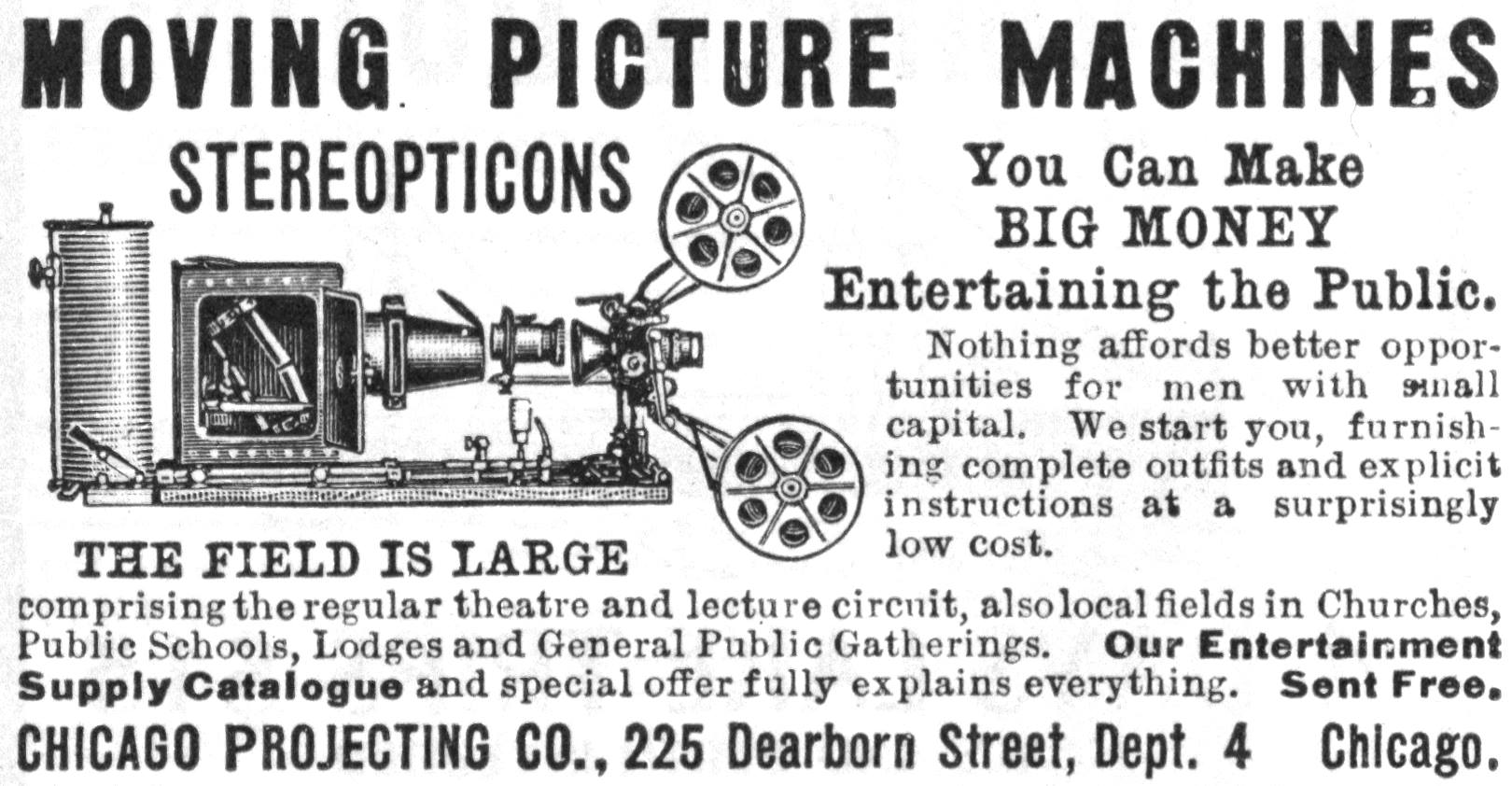
In magazine ads, Chicago Projecting assured traveling exhibitors it could make them rich.
The Chicago Projecting Company was a major player in how films, generally short and designed to amaze, reached their excited public. Its catalogs told these traveling exhibitors how to go about this new trade. And one showman, it appears, left behind Nemeth’s copy in Michigan or somewhere nearby.
At the time Nemeth acquired it, it remained in decent condition, its paper crisp and glossy, but its cover was fragile, and made from poorly preserved pulp cardboard. With all his reading of the catalog, over the years, its binding weakened, but that suited him, because he had long wanted to pull the publication apart and copy and reissue it.
During 2012, the cover did come off, so he figured the time had arrived, he wrote in The Silent Film Quarterly. So he carefully disassembled it, easing sections off the original thick steel staples. He scanned the pages in high definition, and then spent many hours refreshing images in a desktop-publishing suite. Before sending the files off to a printer, he added introductory remarks about the significance of the publication, which came to 438 pages, including the original catalog’s 334 pages. Nemeth’s 1907 Chicago Projecting Co’s Entertainer’s Supplies Catalog No. 122: Deluxe Reprint Edition is the catalog’s first reprinting in over 100 years. It’s available on Ebay, from Nemeth’s audio-equipment company’s site.

Nemeth’s edition of the catalog
It is, in one sense, a curious historical document, Nemeth says by phone from about 40 miles northwest of Detroit in Waterford, Michigan, a township where he settled after growing up in Saginaw. It provides a window into the work life of the traveling film showman, but it also dates from near the end of the era when the movie business operated in that way. “Back then,” explains Nemeth, “you had to buy your film prints outright, and if you went from town to town showing the same film prints…” Well, that would hardly work. So audiences were able to attend a variety of movie shows – presentations of motion pictures as well as hybrids such as the stereopticon lecture. The catalog reflects the hectic activity of that world, although it was an industry that was largely confined to New York and elsewhere in the Northeast of the United States, with hardly any activity west of Chicago, and perhaps none at all in places like California or even Utah. Probably only about 100 people worked from the catalog, he estimates.
Chicago’s importance in early movie history is not general knowledge, now. In their Flickering Empire: How Chicago Invented the U.S. Film Industry, published in 2015, Michael Glover Smith and Adam Selzer note that at one point, a century ago, it could claim to be the capital of motion-picture production, and that even before that, during the first decade of the 20th century, “Chicago’s role in the movie industry, as it was in so many other U.S. industries, was to function primarily as a center for distribution throughout the Midwest.” Sears and Roebuck published a catalog to sell projectors and slide presentations to traveling entrepreneurs, for illustrated-lecture tours. And “many other local companies catered to the burgeoning motion-picture market by selling films and film equipment. These companies included Montgomery Ward (who had set up a special department catering to the ‘optical trade’), the Kleine Optical Company, the Stereopticon and Film Exchange, the Chicago Projecting Company, and the Enterprise Optical Company.”
Thomas Edison, the authors note, “sued or threatened to sue all of those companies,” and he almost succeeded in monopolizing the industry, as he largely did in the New York and New Jersey region, his base. But Chicago companies resisted, and while their New York-region counterparts’ capitulation shackled innovation there, Chicagoans pressed ahead.
n
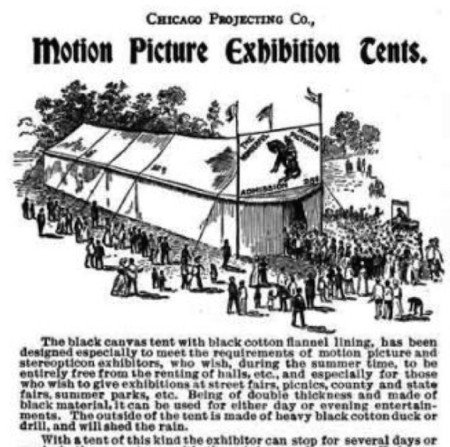
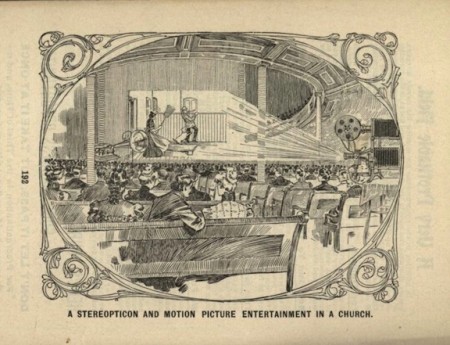
Illustrations from Chicago Projecting’s catalog
n
Evident, in the 1907 catalog, is the preceding decade’s feverous activity around the advent of film during the heyday of the American industrial age. The text and hundreds of illustrations present some 1,050 pre-Hollywood films and 1,000 stereopticon slides and slide sets, along with more than 280 motion-picture and stereopticon projectors, moving-picture machines, and gramophones.
Among striking aspects of the nascent industry is the range of the hardware: so many machines and parts designed and milled, often ornately. Some projectors featured gold pinstripes and other flourishes. “It was the industrial age; people I guess overdid things, back then,” says Nemeth. “That was just the way they did things. They used to do the same with locomotives, bank vault doors, most industrial things that I’ve been around. Even in a sugar plant, the stuff they did going back to 1910 was designed with ornamentation in it.”
To make that world more accessible for modern readers, Nemeth has added notes and indexes, along with his introduction. But much of the content of the catalog requires little explanation. That includes, for instance, the many thumbnail descriptions of available films, most of them animated or live shorts and not yet full-blown narratives. Not many copies of films were made for distribution — scores, rather than the several thousand that came to be made for distribution and simultaneous presentation around the country and world — so even the now-seemingly negligible one-reel films were given plenty of ink.
n

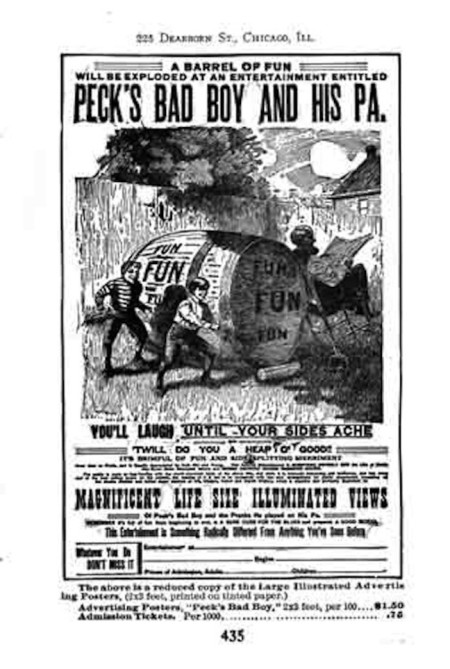
n
entertainments of the day
The catalog’s extensive film and slide-set listings give a good sense of what was popularly demanded, or at least what early film makers thought they could profitably pitch to audiences: selections like Ten Nights in a Barroom, The Clown and Automaton, Twentieth Century Building, and a title featuring a “novel and amusing” illusion of an incubator that hatches chickens straight from cracked eggs…
Other offerings depicted prize fights, tourist attractions like Niagara Falls, ice yachting, temperance rallies, trains, religious ceremonies, cock fights, and scenes of the West Indies. Amphitrite presented “a beautiful and mystifying…girl clad in tights…seen going through numerous graceful evolutions under water.” The greatest of all practitioners of the Serpentine Dance had “set the tongue of the theater-going public wagging as it has never wagged before.” That title is well-known to many silent-film devotees, even today, as are others on the Chicago Projecting list, like A Trip to the Moon and The Whole Damm Family and the Damm Dog.
All 98 feet and minute and a half of Dogs and Rats, made in 1904 by Pathe Frères, are now lost other than for the seven frames that the catalog used to tout it: A fox terrier “devouring rats by the score, some of which understandably “show fight, one in particular fastening his teeth in one of the hind legs of the dog, but he quickly takes flight and meets his death like all the rest. This picture is full of animation and interesting situations.”
Or, the showman could buy the short, 75 feet of “a winner” of “an extremely lean man and an extremely fat man” wrestling: “The lean man attacks the fat one viciously but cannot budge him from the floor. After wrestling furiously for awhile, the fat man falls upon the lean one and crushes him as flat as a pancake.”
Or, a short of Professor Barnum on a stage with his “famous trunk,” displaying posters of a comedian, a strong man, a “freak,” a “cannibal,” a “bearded lady,” and a “soubrette,” as pert maids were called, in some quarters.
Slide sets had titles like “All the Consequences of Married Life,” “How Jones Become a Mason” showing “a weird initiation scene: Jones being tossed in the air by the goat”; and “War,” in which cats fight, a dog enters the fray, and a man’s boot, “and pandemonium reigns supreme.”
For a splurge, the non-risk-averse entrepreneur could lay out $43.80 on 385 feet of film depicting an “eccentric burglary” where trick editing allowed to police officers to pursue burglars by sliding up a ladder.
Or he could take an even more daring punt and lay out $85.86 (about $2000, in today’s $US) for Pathé Frères’ Martyrs of the Inquisition, “one of the most realistic and vivid reproductions” of a medieval torture chamber. If that’s your idea of a fresh Friday night date, good luck to you.
the early film catalog
An earlier edition of the Chicago Projecting Co.’s catalog – in fact, the first, from 1900 — is available on the Internet Archive. It’s a slimmer version of Nemeth’s no. 109, and unsurprisingly some of its listings are for projectors and other equipment less sophisticated than the 1907 versions.
But something less cheerful had happened by 1907, for traveling film showmen. Their dominance of the burgeoning movie market was slipping. Nemeth wrote in Silent Film Quarterly: “Vaudeville troops and nickel-admission movie theaters (nickelodeons) whose films were supplied by film exchanges were gaining popularity. And the fact that the traveling showman had to buy his own prints and slides outright limited what he would show. They were also exorbitantly expensive and easily damaged while out on the road.”
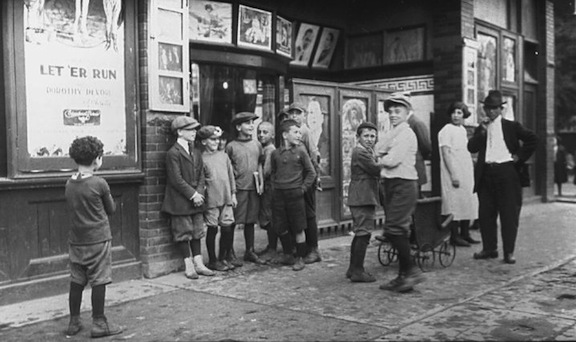
Some guardians of moral order said nickelodeons led youth astray — certainly you wouldn’t want to mess with gangs of pipsqueaks like these.
n
Beginning in 1905, says Nemeth, by phone from his Michigan home, “all of a sudden, nickelodeons started popping up, and they got their film prints through renting them. Well, that puts everybody out of business who’s traveling.”

Darren Nemeth
Manufacturers of equipment fared better, because nickelodeons — the early, small movie theaters — required sturdier, more expensive projectors. “They ran movies day in and day out,” Nemeth explains. “And you can’t really do that with those early projectors because they’re not built for that kind of work.” Among equipment that Chicago Presenting sold was its own line of Optigraph 35mm movie projectors, and the 1907 catalog offered the last of the Optigraph machines before the company changed the brand name to Motiograph around 1908. Nemeth explains that the Motiograph projector was sturdier and better suited to the emerging nickelodeon market, where frequently repeated running of films became the norm and which also saw the advent of a film-exchange business model to replace the practice of outright purchases of films.
Electronics is Nemeth’s business, so he knows well the challenges of manufacturing. He runs Giant Squid Audio Lab, a one-and-a-bit-man company that makes miniature stereo and mono cardioid and omnidirectional microphones — lavalier mics of the kind that attach to collars and ties, for such uses as podcast recording.
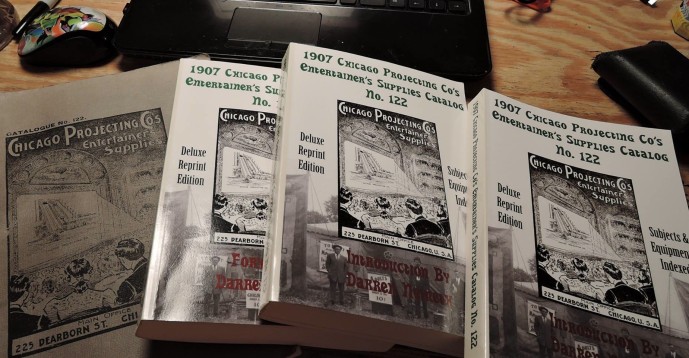
not done with the Chicago Projecting Company
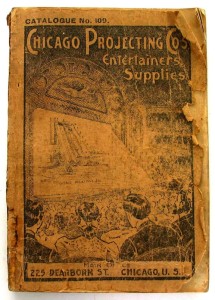 Nemeth isn’t done with the Chicago Projecting Company, nor its Entertainer’s Supplies Catalog. In March 2016, he commented on his first publication’s Facebook page that he had bought another edition of it, and would scan and reprint it, too. It’s No. 109, from about 1902 (right), and differs in some interesting ways from the one he has just published, and from the 1900 edition — No. 100, the company’s first — that is on the Internet Archive. Other examples of early film catalogs, dating back as far as the last decade of the 19th century, are online via New Jersey Digital Highway; such as one from 1906 that was issued by a near neighbor of Chicago Projecting (225 Dearborn Street), Eugene Cline & Company (59 Dearborn).
Nemeth isn’t done with the Chicago Projecting Company, nor its Entertainer’s Supplies Catalog. In March 2016, he commented on his first publication’s Facebook page that he had bought another edition of it, and would scan and reprint it, too. It’s No. 109, from about 1902 (right), and differs in some interesting ways from the one he has just published, and from the 1900 edition — No. 100, the company’s first — that is on the Internet Archive. Other examples of early film catalogs, dating back as far as the last decade of the 19th century, are online via New Jersey Digital Highway; such as one from 1906 that was issued by a near neighbor of Chicago Projecting (225 Dearborn Street), Eugene Cline & Company (59 Dearborn).
But the catalogs of the Chicago Projecting Company are rare in their rich illustration.
— Peter Monaghan
Previous Post: Who Is Crazy? Always a Good Question
Next Post: A Vengeful, but Oddly Unsorrowful Belladonna



